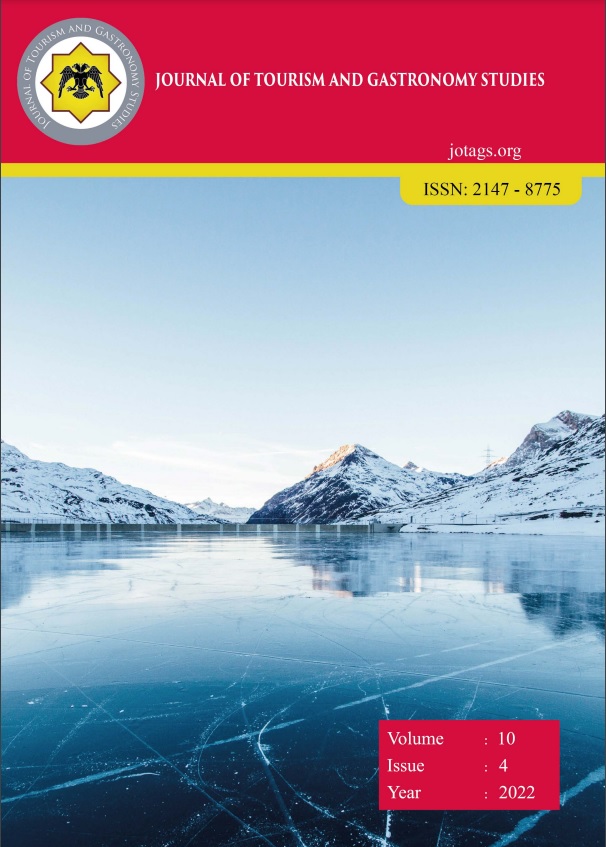Restoran Atmosferinin Memnuniyet ve Tekrar Ziyaret Niyeti Üzerindeki Etkisi (The Effect of Restaurant Atmosphere on Satisfaction and Revisit Intention)
DOI:
https://doi.org/10.21325/jotags.2022.1121Keywords:
Restaurant atmosphere, Physical environment, Satisfaction, Revisit, DinescapeAbstract
The culture of eating out is becoming more and more common all over the world. Restaurant businesses that want to respond to increasing demands and increase their profits focus on customer satisfaction under harsh competition conditions. The restaurant atmosphere, which is an important factor for customer satisfaction, helps to gain loyal customers. The aim of this study is to determine the effect of restaurant atmosphere on satisfaction and revisit intention. For this purpose, data were collected from customers of a luxury restaurant through online and face-to-face surveys. 429 customers participated in the research. The data were analyzed with the SPSS program. The results showed that many sub-dimensions of restaurant atmosphere had an effect on satisfaction and revisit intention. The layout dimension of the restaurant atmosphere did not have an effect on satisfaction, and the lighting dimension did not have an effect on the intention to revisit. The data obtained from the research show that restaurant atmosphere is an important factor for satisfaction and revisit intention. This is a result that should be taken into account by restaurant operators and managers.
References
Abdien, M. (2020). An assessment of dinescape and customers’ behavioral intentions in fast food restaurants. Journal of Tourism Research, 23, 17–30.
AbuThahir, S.-B. S., & Krishnapillai, G. (2018). How does the Ambience of cafe affect the revisit ıntention among its patrons? A S on the Cafes in Ipoh, Perak. Içinde S. A. Aljunid, M. A. A. Mohd Salleh, C. B. M. Rashidi, P. J. Soh, & K. N. F. Ku Azir (Ed.), MATEC Web of Conferences (ss. 1–16). https://doi.org/10.1051/matecconf/201815005074
Aziz, N. A., Ariffin, A. A. M., Omar, N. A., & Evin, C. (2012). Examining the impact of visitors’ emotions and perceived quality towards satisfaction and revisit intention to theme parks. Jurnal Pengurusan, 35, 97–109. https://doi.org/10.17576/pengurusan-2012-35-09
Babin, B. J., Lee, Y., Kim, E., & Griffin, M. (2005). Modeling consumer satisfaction and word‐of‐mouth: restaurant patronage in Korea. Journal of Services Marketing, 19(3), 133–139. https://doi.org/10.1108/08876040510596803
Baker, J., Parasuraman, A., Grewal, D., & Voss, G. B. (2002). The influence of multiple store environment cues on perceived merchandise value and patronage intentions. Journal of Marketing, 66(2), 120–141. https://doi.org/10.1509/jmkg.66.2.120.18470
Baker, J., Levy, M., & Grewal, D. (1992). An experimental approach to making retail store environmental decisions. Journal of Retailing, 68(4), 445.
Baron, R.A. (1990). Lighting as a source of positive affect. Progressive Architecture, 71, 123- 124.
Bichler, B. F., Pikkemaat, B., & Peters, M. (2020). Exploring the role of service quality, atmosphere and food for revisits in restaurants by using a e-mystery guest approach. Journal of Hospitality and Tourism Insights, 4(3), 351–369. https://doi.org/10.1108/JHTI-04-2020-0048
Chen, J. S., & Gursoy, D. (2001). An investigation of tourists’ destination loyalty and preferences. International Journal of Contemporary Hospitality Management, 13(2), 79–85. https://doi.org/10.1108/09596110110381870
Cole, S. T., & Chancellor, H. C. (2009). Examining the festival attributes that impact visitor experience, satisfaction and re-visit intention. Journal of Vacation Marketing, 15(4), 323–333. https://doi.org/10.1177/1356766709335831
Cole, S. T., & Scott, D. (2004). Examining the mediating role of experience quality in a model of tourist experiences. Journal of Travel & Tourism Marketing, 16(1), 79–90. https://doi.org/10.1300/J073v16n01_08
Cristo, M., Saerang, D. P. E., & Worang, F. G. (2017). The Influence of price, servıce quality, and physical environment on customer satisfactıon. Case study markobar cafe mando. Jurnal EMBA, 5(2), 678–686. Tarihinde adresinden erişildi http://cekindo.com/restaurant-market-experienceing-great-
Fuentes-Blasco, M., Moliner-Velázquez, B., & Gil-Saura, I. (2014). Effect of customer heterogeneity on the relationship satisfaction–loyalty. Revista Española de Investigación de Marketing ESIC, 18(2), 78–92. https://doi.org/10.1016/j.reimke.2014.06.002
Githiri, M. N. (2016). Influence of physical environment on customer satisfaction and return ıntention in Kenyan rated restaurants. Asian Journal of Social Science Studies, 2(1), 11. https://doi.org/10.20849/ajsss.v2i1.82
Gül, M., (2022). Kahramanmaraş tematik mutfak müzesi ve dondurma müzesinin gastronomi turizmi kapsamında değerlendirilmesi. Ağrı İbrahim Çeçen Üniversitesi Sosyal Bilimler Enstitüsü Dergisi, 8(1), 312-334.
Han, H., & Hyun, S. S. (2017). Impact of hotel-restaurant image and quality of physical-environment, service, and food on satisfaction and intention. International Journal of Hospitality Management, 63, 82–92. https://doi.org/10.1016/j.ijhm.2017.03.006
Han, H., & Ryu, K. (2009). The roles of the physical environment, price perception, and customer satisfaction in determining customer loyalty in the restaurant industry. Journal of Hospitality and Tourism Research, 33(4), 487–510. https://doi.org/10.1177/1096348009344212
Heung, V. C. S., & Gu, T. (2012). Influence of restaurant atmospherics on patron satisfaction and behavioral intentions. International Journal of Hospitality Management, 31(4), 1167–1177. https://doi.org/10.1016/j.ijhm.2012.02.004
Horng, J. S., Hu, M. L., Hong, J. C., & Lin, Y. C. (2011). Innovation strategies for organizational change in a tea restaurant culture: A social behavior perspective. Social Behavior and Personality, 39(2), 265–274. https://doi.org/10.2224/sbp.2011.39.2.265
Howard, J. A. & Seth, J.N. (1969), The Theory of Buyer Behaviour, John Wiley and Sons, New York, NY.
Hul, M. K., Dube, L., & Chebat, J.-C. (1997). The impact of music on consumers’ reactions to waiting for services. Journal of Retailing, 73(1), 87–104. https://doi.org/10.1016/S0022-4359(97)90016-6
Hwang, J., & Ok, C. (2013). The antecedents and consequence of consumer attitudes toward restaurant brands: A comparative study between casual and fine dining restaurants. International Journal of Hospitality Management, 32, 121–131. https://doi.org/10.1016/j.ijhm.2012.05.002
İşçi, C., Tüver, I., & Güzel, B. (2018). Dinescape factors affecting the satisfaction and loyalty of fish restaurant customers. Journal of Tourism and Gastronomy Studies, 6(2), 4–22. https://doi.org/10.21325/jotags.2018.199
Kalaycı, Ş. (2010). SPSS Uygulamalı Çok Değişkenli İstatistik Teknikleri (5. baskı). Ankara: Asil Yayın.
Karaca, K. Ç., & Köroğlu, Ö. (2018). Restoran atmosferinin tekrar ziyaret niyetine etkisi: Akış deneyiminin aracılık rolü. Avrasya Uluslararası Araştırmalar Dergisi, 6(15), 776–797.
Keskin, E., Solunoğlu, A., & Aktaş, F. (2020). Yiyecek içecek işletmelerinde memnuniyetin tekrar ziyaret niyeti üzerindeki etkisinde atmosfer ve sadakatin aracı ve düzenleyici rolü; Kapadokya örneği. Journal of Tourism and Gastronomy Studies, 8(2), 1222–1246. https://doi.org/10.21325/jotags.2020.605
Kotler, P. (1973). Atmospherics as a marketing tool. Journal of Retailing, 49(4), 48–64.
Kurtich, J., & Eakin, G. (1993). Interior Architecture. Van Nostrand Reinhold, New York.
Lin, I. Y. (2004). Evaluating a servicescape: the effect of cognition and emotion. International Journal of Hospitality Management, 23(2), 163–178. https://doi.org/10.1016/j.ijhm.2003.01.001
Liu, P., & Tse, E. C. Y. (2018). Exploring factors on customers’ restaurant choice: an analysis of restaurant attributes. British Food Journal, 120(10), 2289–2303. https://doi.org/10.1108/BFJ-10-2017-0561
Liu, Y., & Jang, S. (Shawn). (2009). The effects of dining atmospherics: An extended Mehrabian–Russell model. International Journal of Hospitality Management, 28(4), 494–503. https://doi.org/10.1016/j.ijhm.2009.01.002
Mannan, M., Chowdhury, N., Sarker, P., & Amir, R. (2019a). Modeling customer satisfaction and revisit intention in Bangladeshi dining restaurants. Journal of Modelling in Management, 14(4), 922–947. https://doi.org/10.1108/JM2-12-2017-0135
Mannan, M., Chowdhury, N., Sarker, P., & Amir, R. (2019b). Modeling customer satisfaction and revisit intention in Bangladeshi dining restaurants. Journal of Modelling in Management, 14(4), 922–947. https://doi.org/10.1108/JM2-12-2017-0135
Marinkovic, V., Senic, V., Ivkov, D., Dimitrovski, D., & Bjelic, M. (2014). The antecedents of satisfaction and revisit intentions for full-service restaurants. Marketing Intelligence and Planning, 32(3), 311–327. https://doi.org/10.1108/MIP-01-2013-0017
Martínez Caro, L., & Martínez García, J. A. (2007). Cognitive–affective model of consumer satisfaction. An exploratory study within the framework of a sporting event. Journal of Business Research, 60(2), 108–114. https://doi.org/10.1016/j.jbusres.2006.10.008
Namkung, Y., & Jang, S. (Shawn). (2008). Are highly satisfied restaurant customers really different? A quality perception perspective. International Journal of Contemporary Hospitality Management, 20(2), 142–155. https://doi.org/10.1108/09596110810852131
Oliver, R. L. (1997). Satisfaction: A Behavioral Perspective on the Consumer (Second). New York, USA: Routledge.
Parasuraman, A. (1997). Reflections on gaining competitive advantage through customer value. Journal of the Academy of Marketing Science, 25(2), 154–161. https://doi.org/10.1007/BF02894351
Petrick, J. F., Morais, D. D., & Norman, W. C. (2001). An Examination of the Determinants of Entertainment Vacationers’ Intentions to Revisit. Journal of Travel Research, 40(1), 41–48. https://doi.org/10.1177/004728750104000106
Polat, M. (2020). Yöresel yemek imajının destinasyon tercihine etkisi. Doğu Coğrafya Dergisi, 25 (43), 183-194. https://doi.org/10.17295/ataunidcd.712430
Ryu, K., & Han, H. (2010). Influence of the quality of food, service, and physical environment on customer satisfaction and behavioral ıntention in quick-casual restaurants: moderating role of perceived price. Journal of Hospitality & Tourism Research, 34(3), 310–329. https://doi.org/10.1177/1096348009350624
Ryu, K., & Han, H. (2011). New or repeat customers: How does physical environment influence their restaurant experience? International Journal of Hospitality Management, 30(3), 599–611. https://doi.org/10.1016/j.ijhm.2010.11.004
Ryu, K., Han, H., & Kim, T.-H. (2008). The relationships among overall quick-casual restaurant image, perceived value, customer satisfaction, and behavioral intentions. International Journal of Hospitality Management, 27(3), 459–469. https://doi.org/10.1016/j.ijhm.2007.11.001
Ryu, K., & Jang, S. S. (2007). The effect of environmental perceptions on behavioral ıntentions through emotions: The case of upscale restaurants. Journal of Hospitality & Tourism Research, 31(1), 56–72. https://doi.org/10.1177/1096348006295506
Ryu, K., & Shawn Jang, S. (2008). DINESCAPE: A scale for customers’ perception of dining environments. Journal of Foodservice Business Research, 11(1), 2–22. https://doi.org/10.1080/15378020801926551
Seçer, İ. (2017). SPSS ve LISREL ile Pratik Veri Analizi (3. baskı). Ankara: Anı Yayıncılık.
Sulek, J. M., & Hensley, R. L. (2004). The Relative Importance of food, atmosphere, and fairness of wait. Cornell Hotel and Restaurant Administration Quarterly, 45(3), 235–247. https://doi.org/10.1177/0010880404265345
Tabachnick, B. G., & Fidell, L. S. (2013). Using Multivariate Statistics (6. baskı). Boston, New York: MA: Allyn & Bacon/Pearson Education.
Temeloğlu, E., Aksu, M., & Saatcı, G. (2019). Restoran Atmosferi oluşturma sürecinde yöneticilerin dikkat ettikleri unsurlar: Bursa örneği. Journal of Tourism and Gastronomy Studies, 7(3), 1640–1655. https://doi.org/10.21325/jotags.2019.440
Temeloğlu, E., Taşpınar, O., & Soylu, Y. (2017). Yiyecek ve içecek işletmelerinde atmosfer, tüketim duyguları, müşteri menuniyeti ve yeniden satın alma davranışı arasındaki ilişkinin incelenmesi. Journal of Tourism and Gastronomy Studies, 5(2), 253–264. https://doi.org/10.21325/jotags.2017.128
Tombs, A., & McColl-Kennedy, J. R. (2003). Social-servicescape conceptual model. Marketing Theory, 3(4), 447–475. https://doi.org/10.1177/1470593103040785
Um, S., Chon, K., & Ro, Y. (2006). Antecedents of revisit intention. Annals of Tourism Research, 33(4), 1141–1158. https://doi.org/10.1016/j.annals.2006.06.003
Uslu, A. (2020). The relationship of service quality dimensions of restaurant enterprises with satisfaction, behavioural intention, eWOM, and the moderating effect of atmosphere. Tourism and Management Studies, 16(3), 23–35. https://doi.org/10.18089/tms.2020.160303
Wakefield, K. L., & Blodgett, J. G. (1996). The effect of the servicescape on customers’ behavioral intentions in leisure service settings. Journal of Services Marketing, 10(6), 45–61. https://doi.org/10.1108/08876049610148594
Wilianto, V., Santoso, N., & Siaputra, H. (2017). Pengaruh physical environment terhadap customer satisfaction yang membentuk behavioral ıntention di domi deli restaurant surabaya: Aplikasi Skala Pengukuran Dinescape. Jurnal Hospitality dan Manajemen Jasa, 5(1), 71–82.
Yan, H., & Felicen, S. S. (2021). Dinescape and servicescape experience among costumers of themed restaurant in Shanghai. International Journal of Research Studies in Management, 9(3), 1–14. https://doi.org/10.5861/ijrsm.2021.m7722
Yüksel, A., & Yüksel, F. (2003). Measurement of tourist satisfaction with restaurant services: A segment-based approach. Journal of Vacation Marketing, 9(1), 52–68. https://doi.org/10.1177/135676670200900104
Downloads
Published
How to Cite
Issue
Section
License
Copyright (c) 2023 Journal of Tourism & Gastronomy Studies

This work is licensed under a Creative Commons Attribution-NonCommercial 4.0 International License.








